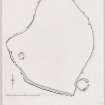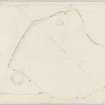Pricing Change
New pricing for orders of material from this site will come into place shortly. Charges for supply of digital images, digitisation on demand, prints and licensing will be altered.
Upcoming Maintenance
Please be advised that this website will undergo scheduled maintenance on the following dates:
Thursday, 9 January: 11:00 AM - 3:00 PM
Thursday, 23 January: 11:00 AM - 3:00 PM
Thursday, 30 January: 11:00 AM - 3:00 PM
During these times, some functionality such as image purchasing may be temporarily unavailable. We apologise for any inconvenience this may cause.
Field Visit
Date 22 October 1955
Event ID 924928
Category Recording
Type Field Visit
Permalink http://canmore.org.uk/event/924928
Fort, Cnoc Na Ratha.
This structure occupies the NE extremity of an inconspicuous flat-topped ridge which is situated in the open moorland immediately N of Ben Shurrery, at a point distant one and a quarter miles NNW of Ben Freicadain. The fort is irregular in plan, the enclosing drystone wall following the contour of the tip of the ridge to take in an area measuring about 300 feet along the ridge by about 230 feet across it, and then continuing as a cross wall to cut off this area from the rest of the ridge. The site is not a particularly strong one as the adjacent part of the ridge immediately SW of the fort continues to rise slightly for some distance. Considerable stretches of the outer face of the wall are visible through the heather and peat covering the site. At three points in the stretch where the wall crosses the ridge and at one in the NE sector short lengths of the inner face opposite or near t o lengths of the outer face indicate that the wall was originally about 8 feet in thickness. Both faces were constructed of thin slabs of stone laid on bed, while the rest of the wall was probably filled with rubble. While the outer face appears frequently along the S, SW, W, NW and N sectors of the wall, there are hardly any traces of it to the NE, E, and SE. The only indication of an entrance is in the NE sector, where the broken stump of a slab about 5 feet in length and about 9 inches in thickness protrudes through the earth on the course of but at right angles to the wall. This probably formed part of one side of the entrance passage.
The ruinous drystone structure measuring 26 feet in external diameter is situated within the W quarter of the fort about 15 feet in from the wall. The stones which are covered in heather, seem to form a thick-walled structure with an entrance to the SE. Stinging nettles grew in the interior on the date of visit. No opinion could be formed about the structure as it stood, but nothing was seen to upset the description of it written in 1910 (RCAHMS 1911, No.355). The interior of the fort is otherwise featureless.
In other respects however, the accounts differ.
A circular structure lies mostly outside, but probably partly upon, the ruin of the SE sector of the fort wall. It measures about 30 feet in diameter within a grass-covered stony mound which probably represents a ruined drystone wall. The entrance, in the NE, gives on the E flank of the ridge which here slopes down from the fort at an angle of about 13 degrees. The floor of the circular structure has been scooped to give a level surface. This structure recalls the pair reported at Garywhin [ND34SW 3]. A large earth-fast slab protrudes through the heather at a point a few feet outside the W angle of the fort. There is nothing to show whether this occurs naturally or not.
Visited by RCAHMS 22 October 1955.











